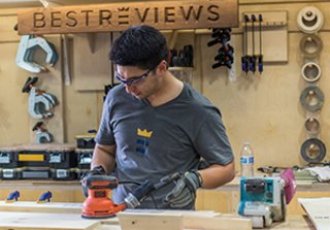We recommend these products based on an intensive research process that's designed to cut through the noise and find the top products in this space. Guided by experts, we spend hours looking into the factors that matter, to bring you these selections.

A standard hammer drill can help you drill a hole in a wall when you’re putting up a shelf, but it isn’t built for heavy-duty drilling. If you want to make big holes in tough material, you need more power, and that’s when you choose an SDS drill. The other advantage with these high-performance tools is that the hammer action can be used on its own. Fit a chisel bit and you can turn it into a light demolition tool.
While the basic technology is similar across all SDS tools, there are different sizes, different power options, and a whole range of features to consider. If you’ve never used one before, picking the right model is not straightforward.
BestReviews has put together a collection of recommended SDS drills that showcase the best options in price and performance. We’ve also added a comprehensive buying guide to explain the details.

There are several things that set a slotted drive system (SDS) drill apart from a standard hammer drill, including power, action, and chuck.
There are three types of SDS drill:
While standard drills are now mostly cordless, the power demands of an SDS drill mean corded models are still very popular. However, there are also numerous cordless models, the best of which are a match with corded in terms of performance, though they do tend to require fairly frequent recharging. A second battery is something of a necessity if you intend to work for extended periods. If you’re buying a cordless model, we strongly suggest that you look for one with a brushless motor. These make much better use of the available battery power than brush motors. While 12-volt models do exist, we would opt for 18 or 20 volts.
You’ll see a variety of performance figures quoted. Impact energy can be given in foot-pounds (ftᐧlb) or joules (J), but direct comparisons are unhelpful because manufacturers use different methods to calculate them. Motor revolutions per minute (rpm), usually given as a no-load speed, and blows per minute (bpm) are more useful. Speed is usually variable by trigger pressure. Chuck size is also a good indication of performance, and it varies from 1 inch to 1.5 inches.
If you’re only going to use one occasionally or for a specific one-off task, buying a cheap SDS drill can be a good idea. Kits that cost $75 to $100 usually come with a small selection of drill and chisel bits.
There are dozens of high-quality SDS and SDS Plus drills, both corded and cordless, that cost between $150 and $350. This is the bracket where we expect most homeowners can find what they needed.
Big, powerful, professional-grade SDS Max drills are at the top of the price range. You’re unlikely to find one under $400, and they can top $550.

A. It depends on the size of the chuck. However, few standard drills have the power to drive large bits effectively. Additionally, a standard chuck doesn’t grip as positively as an SDS sliding chuck, so there’s a danger that in heavy-duty drilling situations, the bit might get stuck, and the drill chuck will just spin around it. It’s not really a viable alternative, and if the chuck should slip and then grab, it could be dangerous.
A. You can, but you’ll need to buy an SDS-to-half-inch chuck adapter (keyed and keyless are available). Once fitted, you can only use the rotary action of the SDS drill, not the hammer drill. These tools are just too powerful and would smash the smaller drill bits to pieces.
A. Yes and no! SDS and SDS Plus have 10 mm shanks and are interchangeable. SDS Max bit have 18 mm shanks, so they won’t fit. Also, be aware that bits for spline drive drills, which can look very similar to SDS models, won’t fit any of the SDS type. SDS Max is designed to replace the more powerful spline drive tools, but the bits are not interchangeable.
Get emails you’ll love.
Learn about the products you’re wondering if you should buy and get advice on using your latest purchases.
